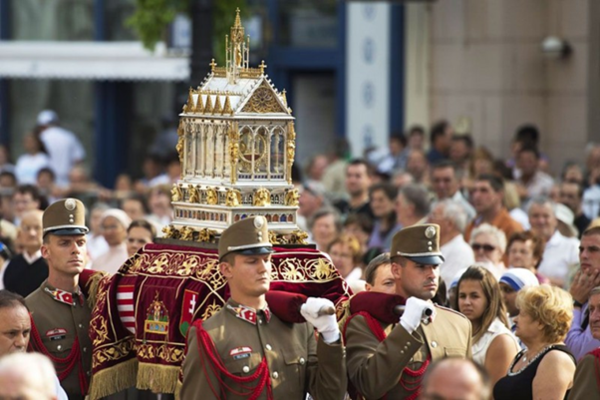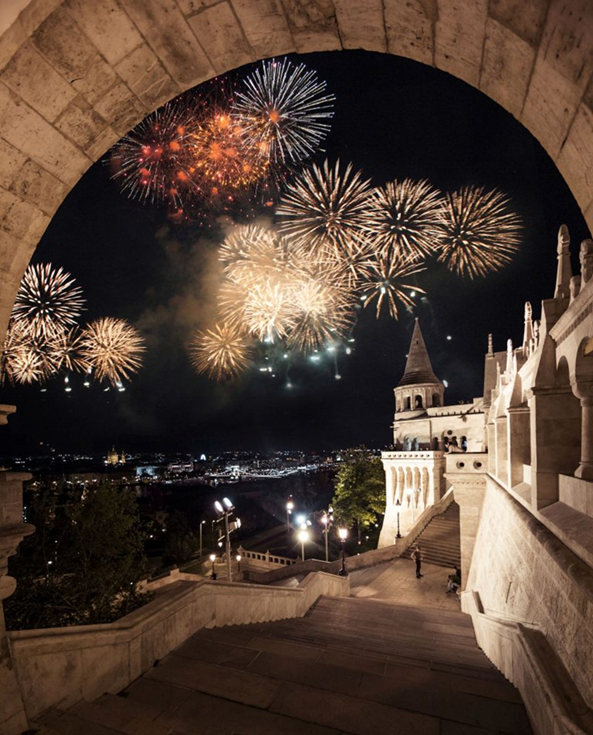
[아츠앤컬쳐] 8월 20일은 헝가리인들의 마음속에 특별한 자리를 차지하고 있는 날이다. 나라에서 가장 오래된 공휴일로, 건국기념일이자 헝가리의 탄생과 초대 국왕인 성 이슈트반/이슈트반 1세의 유산을 기리는 날이다.
천 년이 훨씬 넘는 과거, 1000년의 어느 날 이슈트반 1세는 ‘신성한 헝가리 왕관’을 쓰고 왕위에 올라, 기독교 왕국의 기초를 닦았다. 이로써 헝가리는 유럽 공동체의 일원으로 자리매김하게 되었다. 그는 독실한 신앙인이었으며, 헝가리를 성모 마리아에게 봉헌하면서 8월 15일, 성모 승천 축일을 이 헌정의 상징적 날짜로 택했다. 그리고 1038년 8월 15일, 그가 세상을 떠나자 이 날짜는 그의 죽음과 더불어 헝가리 국민에 대한 영적 수호자의 의미를 함께 지니게 되었다.

이후 성 라슬로 왕(성 라디슬라우스) 치하에서 기념일은 8월 20일로 옮겨졌다. 1083년, 교황 그레고리오 7세는 이슈트반 1세의 시성을 축복하고, 그가 남긴 유물들, 특히 ‘성스러운 오른손’을 세케쉬페헤르바르 대성당의 제단에 안치했다. 이로써 그는 공식적으로 시성되었고, 헝가리의 첫 번째 수호성인으로 확고히 자리매김했다.
오늘날 8월 20일은 수백 년에 걸친 전통과 민족 자긍심이 현대적으로 생생하게 표현되는 날이다. 전국의 가톨릭 성당에서는 성 이슈트반을 기리는 특별 미사가 열리고, ‘새로운 빵을 위한 축제’는 헝가리의 농업 유산을 상기시켜 준다. 이 축제는 새로 수확한 밀로 구운 첫 번째 빵을 기념하는 전통으로, 국기 색인 빨강, 하양, 초록 리본이 묶인 갓 구은 빵은 축복을 받고 공동체 안에서 나뉜다. 이는 수확에 대한 감사와 쇄신의 약속을 상징한다.

부다페스트에서는 코슈트 광장의 국회의사당 앞에서 헝가리 국기 게양식으로 하루를 시작한다. 이후에는 훌륭한 업적을 이룬 시민들에게 국가 훈장이 수여되며, ‘헝가리의 케이크’ 절단식도 열린다. 이 상징적인 디저트는 헝가리 음식 문화의 창의성을 보여주는 대표적인 행사다. 이날의 하이라이트 중 하나는 ‘성스러운 오른손’의 행진이다. 유리관에 담긴 이 유물은 도시를 가로지르는 행렬을 통해 시민들과 조우하며, 과거의 군주와 오늘날의 국민을 잇는 감동적인 순간을 만들어낸다.
저녁이 되면 축제의 대미를 장식하는 불꽃놀이가 다뉴브강 위 하늘을 화려하게 수놓는다. 1927년부터 이어져 온 이 전통은 부다페스트 전역의 다리와 강둑을 따라 수많은 인파가 모여 함께 즐기는 장관으로, 세대를 아우르는 소속감과 공동체 의식을 불러일으킨다.
헝가리인들에게 8월 20일은 단순한 공휴일이 아니라, 고대와 현대, 신앙과 자유, 지나간 꿈과 다가올 희망을 이어주는 기념과 쇄신의 날이다.

August 20: A Day of Remembrance and Renewal in Hungary
August 20 holds a special place in the hearts of Hungarians. Known as the country’s oldest public holiday, it is celebrated as the Day of State Foundation — a time when Hungarians honor the birth of their nation and the legacy of Saint István, or Stephen I, their first king and the founder of the Hungarian state.
More than a thousand years ago, in the year 1000, István I was crowned with the Holy Crown of Hungary, laying the foundations of a Christian kingdom that would take its place within the community of European nations. Deeply devoted to the Christian faith, he dedicated Hungary to the Virgin Mary, initially choosing August 15, the Feast of the Assumption, to symbolize this offering. When he died on August 15, 1038, the date became all the more significant as the day marked both his passing and his enduring spiritual guardianship over the Hungarian people.
Later, under King Saint László (Saint Ladislaus), the celebration shifted to August 20. In 1083, Pope Gregory VII gave his blessing for István I’s canonization, and his revered relics — especially the Holy Right Hand — were placed on the altar of the Basilica in Székesfehérvár. This act marked the king’s canonization and firmly established him as Hungary’s first patron saint.
Today, August 20 brings together centuries-old traditions with vibrant modern expressions of national pride. Catholic churches across the country hold special masses in memory of St. István, while the Festival of the New Bread reminds Hungarians of their agricultural heritage. This beloved harvest tradition celebrates the first bread made from the season’s new wheat. Fresh loaves tied with ribbons in the red, white, and green of the national flag are blessed and shared among communities, symbolizing gratitude for the harvest and the promise of renewal.

In Budapest, the celebrations begin with the solemn hoisting of Hungary’s national flag on Kossuth Square before the Parliament building. The day continues with the presentation of state honors to remarkable citizens, and the carving of the Cake of Hungary — a symbolic sweet treat showcasing the country’s culinary creativity. One of the most moving traditions is the procession of the Holy Right Hand through the streets, connecting present-day citizens with the legacy of their founding king.
As dusk falls, the grand finale arrives: a dazzling firework display over the Danube River. Since 1927, the night sky above Budapest has come alive with color and light on this day, watched by thousands gathered along the river’s bridges and banks — a breathtaking spectacle that unites generations in a shared sense of belonging.
For Hungarians, August 20 is far more than just a holiday; it is a moment of remembrance and renewal, linking the ancient with the modern, faith with freedom, and the dreams of the past with hopes for the future.

글 ㅣ 루자 카타린 Katalin Ruzsa
주한리스트헝가리문화원 문화사무관
Liszt Institute - Hungarian Cultural Center Seoul


